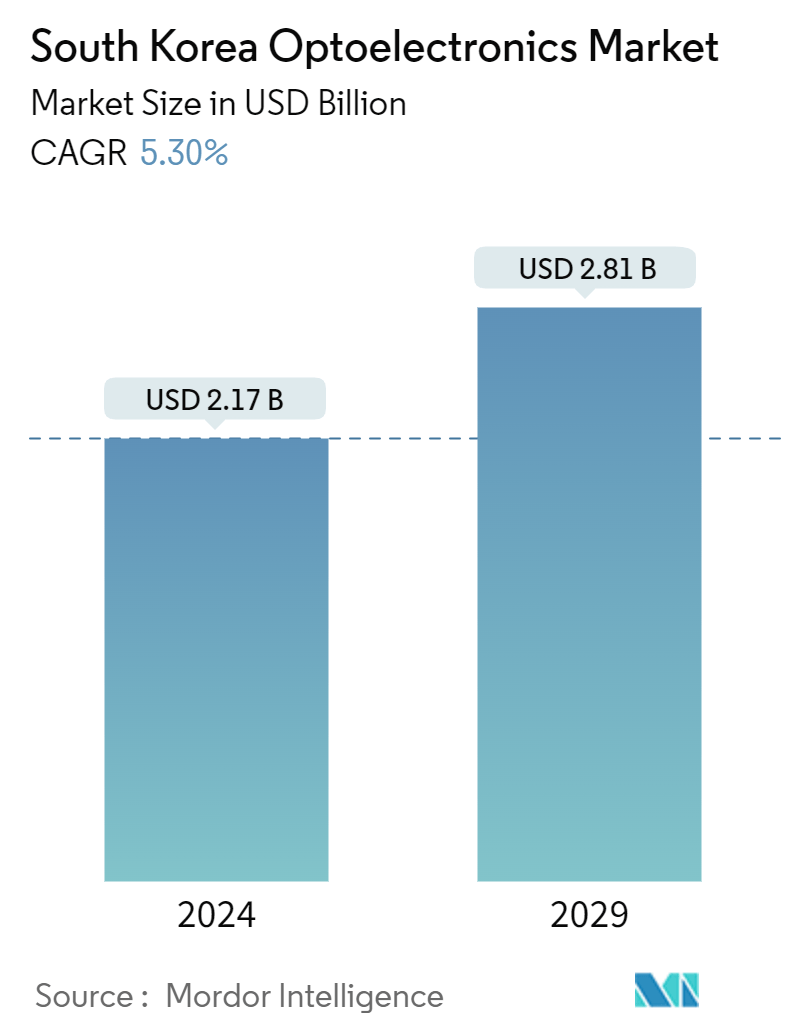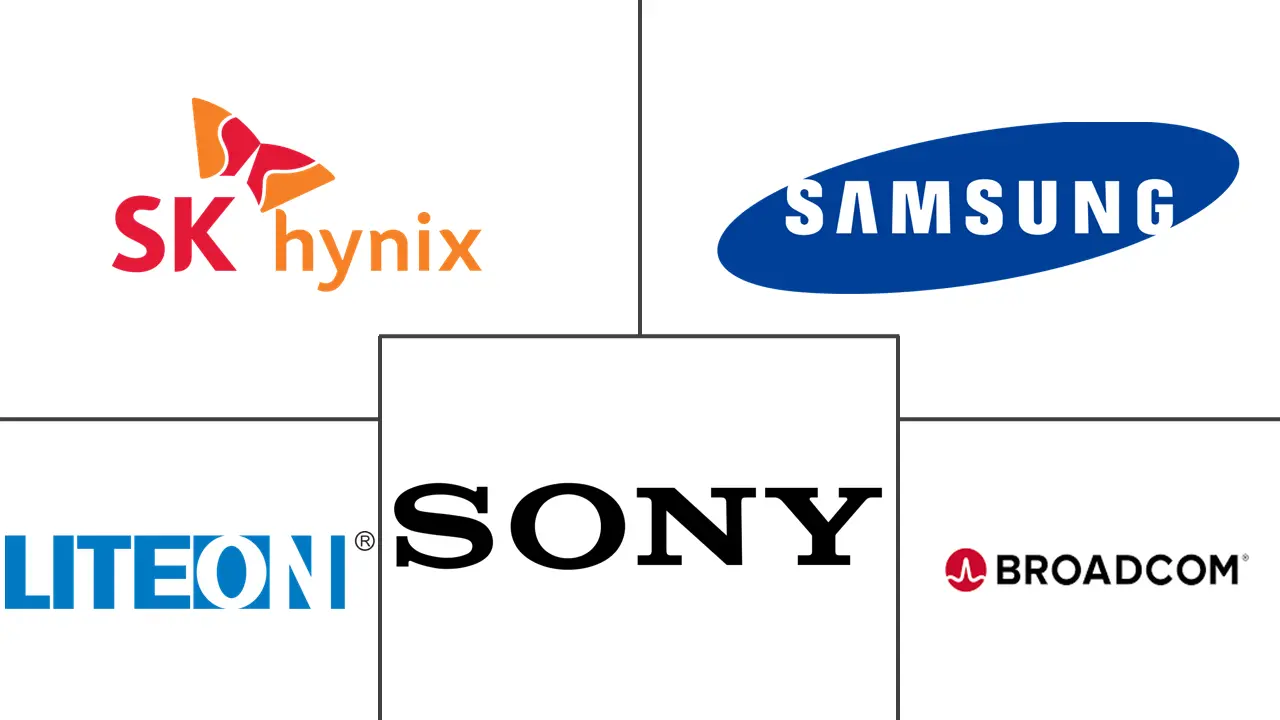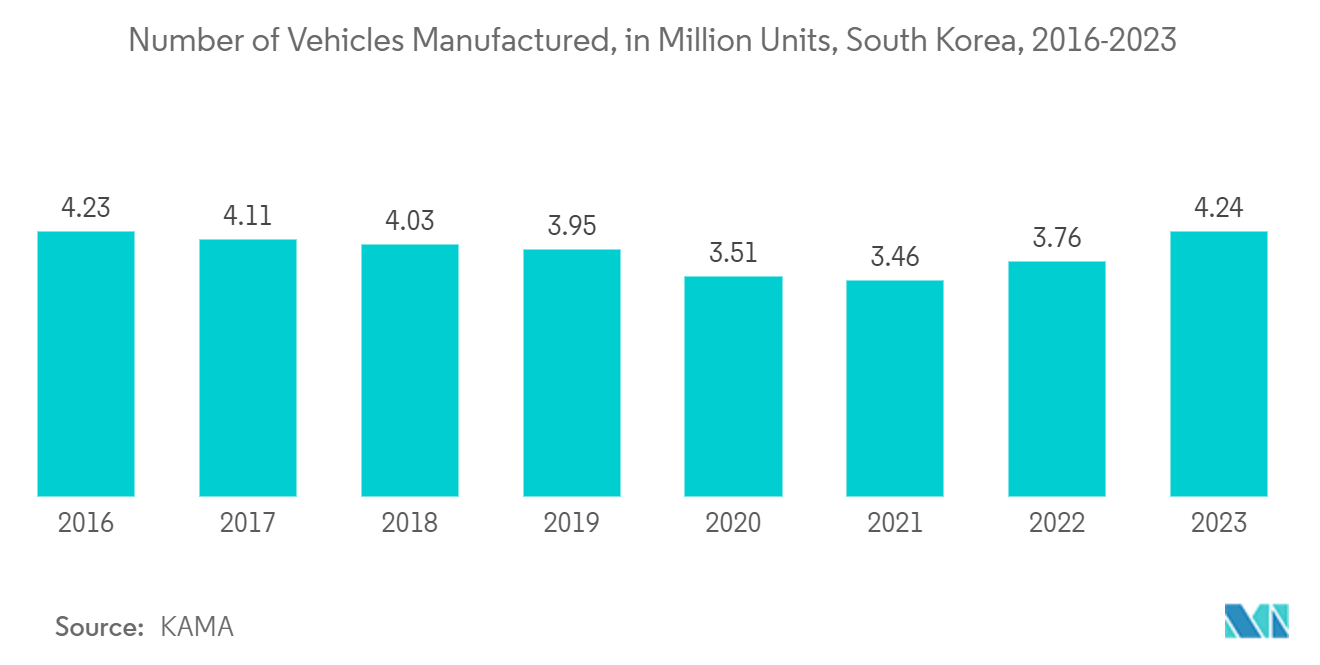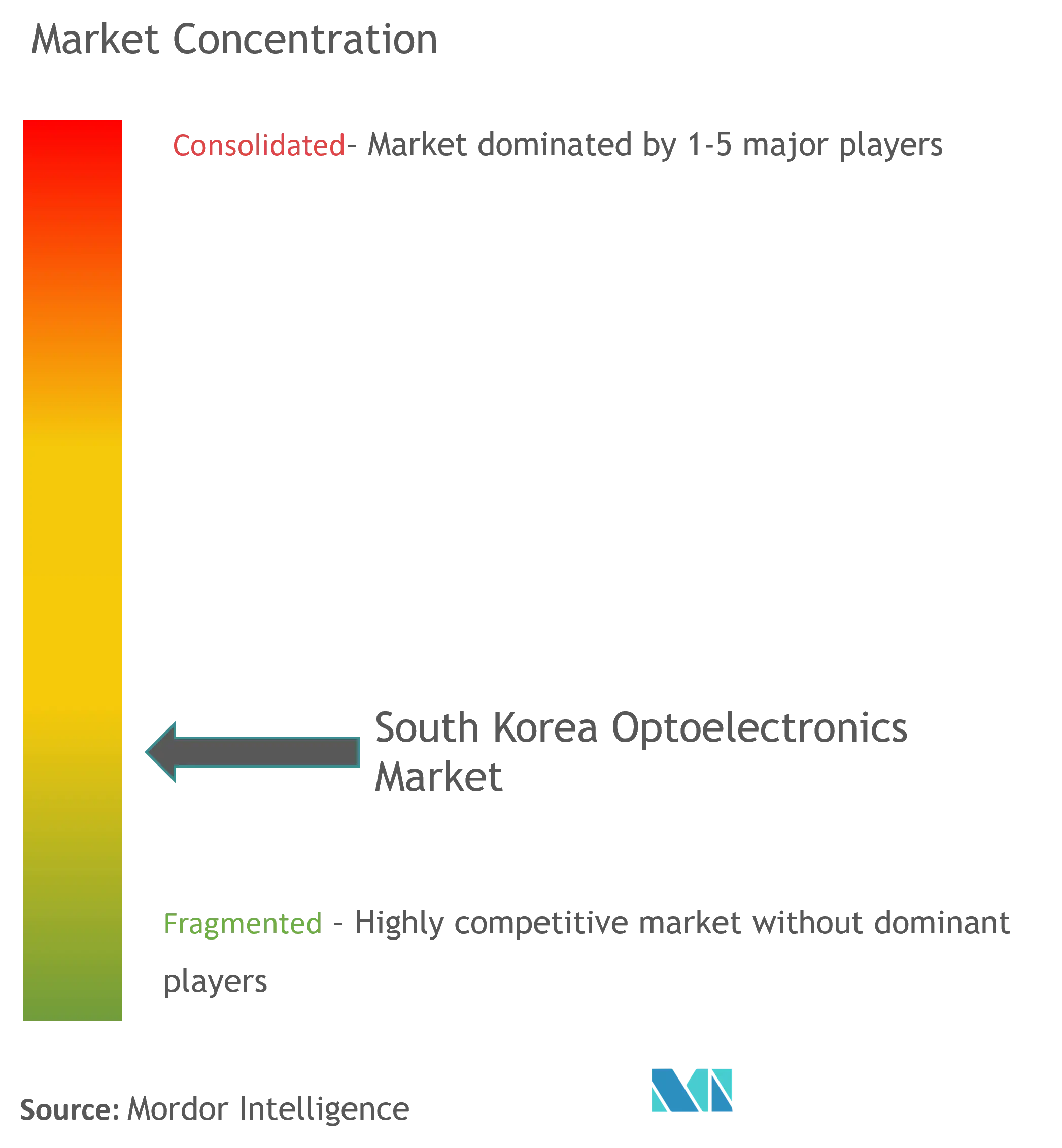South Korea Optoelectronics Market Size

| Study Period | 2019 - 2029 |
| Base Year For Estimation | 2023 |
| Market Size (2024) | USD 2.17 Billion |
| Market Size (2029) | USD 2.81 Billion |
| CAGR (2024 - 2029) | 5.30 % |
| Market Concentration | Low |
Major Players
*Disclaimer: Major Players sorted in no particular order |
South Korea Optoelectronics Market Analysis
The South Korea Optoelectronics Market size is estimated at USD 2.17 billion in 2024, and is expected to reach USD 2.81 billion by 2029, growing at a CAGR of 5.30% during the forecast period (2024-2029).
- Optoelectronics (or optronics) is a branch of electronics that focuses on studying and applying devices and systems that detect, control, and emit light. This field encompasses a variety of light forms, including visible light, infrared, ultraviolet, and even gamma rays and X-rays. Optoelectronic devices function as transducers, converting electrical signals into optical signals and vice versa. They are primarily based on the quantum mechanical effects of light interacting with electronic materials, particularly semiconductors.
- Optoelectronics provide electrical isolation, allowing two systems that operate at different voltages to interface. This helps in limiting data transmission issues caused by induced noise, crosstalk, and signal degradation due to worn runs. Optoelectronics provide a high bandwidth for communications, which is advantageous in various applications like telecommunications and data transmission. Optoelectronic devices consume less power, making them energy-efficient and suitable for applications where power consumption is a concern.
- The rising demand for consumer electronics is another crucial driver of the optoelectronics market. South Korea is one of the largest consumers of electronics, with a high penetration of smartphones, tablets, and smart home devices. The integration of optoelectronics components, such as sensors and displays, in these devices is driving market growth.
- Moreover, the increasing trend toward smart appliances and the Internet of Things (IoT) is further propelling the demand for optoelectronic components. As consumers seek more interconnected and intelligent devices, manufacturers are compelled to incorporate optoelectronic technologies to meet these expectations.
- LEDs are utilized in optical sensors for various automation applications, including object detection, position sensing, and motion control within factory environments. Also, LED lighting systems are extensively used in factory automation to provide efficient and durable illumination. They contribute to energy savings and improved visibility in industrial settings.
- Moreover, LEDs play a crucial role in machine vision systems used for quality control, inspection, and monitoring processes in factory automation. They provide consistent and reliable lighting for imaging applications. LED optoelectronics are utilized in control panels and indicators to display status, alerts, and operational information within automated systems. The increase in factory automation in South Korea is likely to drive the demand for the market studied .
- Furthermore, favorable government ambitions in the region have helped to strengthen the awareness and training of skilled workers in the smart factory environment. The government of South Korea announced that it would provide support to train 40,000 skilled workers to operate fully automated manufacturing sites through several educational programs while diversifying support.
- To keep up with the rapid digitalization and automation in the Fourth Industrial Revolution, the government revised its target of smart factories. Originally set at 10,000 by 2020, the new aim is to achieve 30,000 smart factories by 2025. Such initiatives are likely to increase the adoption of factory automation, thereby driving the growth of the market studied.
- However, high manufacturing and fabrication costs and challenges with energy loss and heating of optoelectronic devices are likely to act as restraining factors in the growth of the market studied. Also, high inflation can significantly impact the optoelectronics market by raising production costs. Higher prices for raw materials, components, and labor can lead to increased manufacturing expenses, which may most likely be passed on to consumers through higher product prices. This can dampen demand, particularly in price-sensitive segments.
- Additionally, inflation can strain consumer purchasing power, leading to reduced investment in advanced technologies. Per the International Monetary Fund (IMF), the average inflation rate in 2023 in South Korea amounted to about 3.59% compared to the previous year.
South Korea Optoelectronics Market Trends
The Image Sensors Segment is Anticipated to Drive the Demand for the Studied Market
- Image sensors are a crucial component in optoelectronics that allows cameras and imaging devices to convert photons into electrical signals that can be interpreted and processed. The first digital cameras used charge-coupled devices (CCDs) to facilitate the movement of electrical charge through the device for modulation. However, modern cameras predominantly use complementary metal-oxide-semiconductor (CMOS) sensors due to their low power consumption, high integration, and compatibility with standard CMOS fabrication processes.
- The emergence of 3D imaging technologies has opened new avenues for image sensors. Applications in augmented and virtual reality are growing, especially in gaming and entertainment, where South Korea has a significant market presence. The integration of depth-sensing capabilities in mobile devices is also driving demand.
- Incorporating artificial intelligence in image processing has enhanced the functionality of image sensors. AI algorithms improve image quality, enable facial recognition, and facilitate various applications in security and surveillance, further expanding the market.
- Further, the consumer electronics sector is a major contributor to the growth of the image sensor market in South Korea. As consumers increasingly prioritize advanced camera technology in their devices, manufacturers are compelled to innovate and enhance their offerings. South Korea is home to major smartphone manufacturers, such as Samsung and LG, who are continuously pushing the envelope regarding camera technology. The demand for multi-camera setups and features like optical zoom and night mode has propelled the need for advanced image sensors.
- Modern manufacturing and logistics distribution centers must increase productivity by increasing conveyor speeds and widening fields of view and working ranges. New CMOS image sensors are emerging onto the market studied and designed especially for scanning applications, representing a significant step forward in industrial applications, thus boosting the growth of the CMOS sensor image market. Robots equipped with CMOS image sensors can inspect and identify components, exactly measure dimensions, or monitor machines or other robots during pick-and-place and assembly operations.
- According to the Bank of Korea, in 2023, South Korea's gross domestic product (GDP) increased by 1.4% year-on-year, while the manufacturing sector grew by roughly 1%. The manufacturing sector makes up a large part of the South Korean economy and has helped South Korea achieve rapid economic growth over the past decades. The robust manufacturing sector in South Korea is highly anticipated to aid the growth of the market studied.

The Automotive Sector is Anticipated to Hold a Major Market Share
- One of the most prominent applications of optoelectronics in the automotive sector is lighting systems. Traditional incandescent lights are being replaced by LED (Light Emitting Diode) technology, which offers better energy efficiency, longer lifespan, and improved brightness. South Korean automotive manufacturers like Hyundai and Kia are increasingly adopting LED technology for headlights, taillights, and interior lighting. Additionally, advanced lighting systems such as Adaptive Front Lighting Systems (AFS) and matrix LED headlights enhance driving safety by automatically adjusting the light distribution based on driving conditions.
- Vehicle displays, including instrument clusters, infotainment systems, and heads-up displays (HUDs), utilize optoelectronic technologies such as LCD (Liquid Crystal Display) and OLED (Organic Light Emitting Diode) screens. These displays help drivers with real-time information, navigation, and entertainment. South Korea's automotive companies are integrating more sophisticated displays into their vehicles to enhance user experience and connectivity.
- The increasing automotive manufacturing is likely to aid the growth of the market studied . For instance, according to the Korea Automobile Manufacturers Association (KAMA), in 2023, approximately 4.24 million units of vehicles were manufactured in South Korea. This increased from nearly 3.76 million units in the previous year, the highest figure recorded since 2015.
- With the upsurge in demand for electric vehicles worldwide and government support to improve domestic manufacturing, South Korean Automakers such as Hyundai, Kia, and Genesis are focusing on increasing production volume and investing heavily in development and manufacturing.
- In March 2024, Hyundai Motor Group announced that it would invest USD 51 billion over three years in South Korea to ramp up electric vehicle production and new mobility business and separately hire 80,000 new employees, doubling down at a time when other established automakers are slowing efforts.
- The push toward autonomous vehicles is a major driver of optoelectronic applications in the automotive industry. Technologies such as LIDAR and camera systems are essential for enabling vehicle autonomy. South Korean companies, including established automakers and startups, are heavily investing in research and development to advance these technologies, thus fueling market growth.

South Korea Optoelectronics Industry Overview
The South Korean optoelectronics market is a fragmented market with the presence of various players like Panasonic Corporation, Samsung Electronics, Omnivision Technologies Inc., Sony Corporation, Osram Licht AG, Koninklijke Philips NV, Vishay Intertechnology Inc., Texas Instruments Inc., LITE-ON Technology Corporation, Rohm Co. Ltd (ROHM SEMICONDUCTOR), Mitsubishi Electric Corporation, Broadcom Inc., Sharp Corporation, SK Hynix Inc., etc. The companies in the market are innovating advanced products that cater to consumers' complex and evolving requirements.
In September 2023, Sony Semiconductor Solutions Corporation announced the release of the IMX735, a new CMOS image sensor for automotive cameras with a high pixel count of 17.42 effective megapixels. The new sensor product would aid the development of automotive camera systems capable of sophisticated sensing and recognition performance, thereby contributing to safe, secure, automated driving.
In September 2023, Getac announced that it had successfully implanted LiFitechnology into its rugged devices as part of a recent innovation project with Signify, the global player in lighting. Signify and Getac is part of the Light Communication Alliance (LCA), a community of industry players, researchers, and innovators who feel in Optical Wireless Communication's power to transform how organizations connect and communicate.
South Korea Optoelectronics Market Leaders
-
SK Hynix Inc.
-
Samsung Electronics
-
Sony Corporation
-
LITE-ON Technology Corporation
-
Broadcom Inc.
*Disclaimer: Major Players sorted in no particular order

South Korea Optoelectronics Market News
- November 2023- Sony Semiconductor Solutions Corporation (SSS) unveiled its latest innovation, the IMX992 short-wavelength infrared (SWIR) image sensor. It features a 5.32 effective megapixels. As per the company, its SSS' pioneering Cu-Cu connection technology enables it to achieve a robust pixel size of just 3.45 μm, the smallest in the SWIR sensor realm. Moreover, the sensor's pixel structure has been optimized to enhance light capture efficiency. It also features an optimized pixel structure for efficiently capturing light. It enables high-definition imaging across a broad spectrum ranging from visible to invisible short-wavelength infrared regions (wavelength: 0.4 to 1.7 μm).
- September 2023 - OmniVision, a prominent global developer of semiconductor solutions, including analog, advanced digital imaging, and touch and display technology, debuted its OX08D10 8-megapixel (MP) CMOS image sensor with TheiaCeltechnology at AutoSensBrussels. The new solution claims to improve automotive safety by providing enhanced image quality and resolution in exterior cameras for autonomous driving and advanced driver assistance systems (ADAS).
South Korea Optoelectronics Market Report - Table of Contents
1. INTRODUCTION
- 1.1 Study Assumptions and Market Definition
- 1.2 Scope of the Study
2. RESEARCH METHODOLOGY
3. EXECUTIVE SUMMARY
4. MARKET INSIGHTS
- 4.1 Market Overview
- 4.2 Industry Value Chain Analysis
-
4.3 Industry Attractiveness Porters Five Forces Analysis
- 4.3.1 Threat of New Entrants
- 4.3.2 Bargaining Power of Buyers
- 4.3.3 Bargaining Power of Suppliers
- 4.3.4 Threat of Substitute Products and Services
- 4.3.5 Intensity of Competitive Rivalry
- 4.4 Impact of COVID-19 Aftereffects and Other Macroeconomic Factors on the Market
5. MARKET DYNAMICS
-
5.1 Market Drivers
- 5.1.1 Growing Demand for Smart Consumer Electronics and Next-generation Technologies
- 5.1.2 Increasing Industrial Applications of the Technology
- 5.1.3 Expansion of the Li-Fi Market
-
5.2 Market Challenges/Restraints
- 5.2.1 High Manufacturing and Fabrication Costs
- 5.2.2 Challenges with Energy Loss and Heating of Optoelectronic Devices
6. MARKET SEGMENTATION
-
6.1 By Device Type
- 6.1.1 LED
- 6.1.2 Laser Diode
- 6.1.3 Image Sensors
- 6.1.4 Optocouplers
- 6.1.5 Photovoltaic cells
- 6.1.6 Other Device Types
-
6.2 By End User
- 6.2.1 Automotive
- 6.2.2 Aerospace and Defense
- 6.2.3 Consumer Electronics
- 6.2.4 Information Technology
- 6.2.5 Healthcare
- 6.2.6 Residential and Commercial
- 6.2.7 Industrial
- 6.2.8 Other End Users
7. COMPETITIVE LANDSCAPE
-
7.1 Company Profiles*
- 7.1.1 SK Hynix Inc.
- 7.1.2 Panasonic Corporation
- 7.1.3 Samsung Electronics
- 7.1.4 Omnivision Technologies Inc.
- 7.1.5 Sony Corporation
- 7.1.6 Osram Licht AG
- 7.1.7 Koninklijke Philips NV
- 7.1.8 Vishay Intertechnology Inc.
- 7.1.9 Texas Instruments Inc.
- 7.1.10 LITE-ON Technology Corporation
- 7.1.11 Rohm Co. Ltd (ROHM SEMICONDUCTOR)
- 7.1.12 Mitsubishi Electric Corporation
- 7.1.13 Broadcom Inc.
- 7.1.14 Sharp Corporation
8. INVESTMENT ANALYSIS
9. MARKET OPPORTUNITIES AND FUTURE TRENDS
** Subject To AvailablitySouth Korea Optoelectronics Industry Segmentation
Optoelectronics involves studying and applying electronic systems that manipulate (find, detect, and control) light, often seen as a subset of photonics. In this context, light encompasses visible light and other forms of radiation, including gamma rays, X-rays, ultraviolet, and infrared. Optoelectronic devices serve as transducers, converting electrical signals to optical and vice versa.
To evaluate the market revenue for the South Korean optoelectronics market, we have tracked the sales of optoelectronic chips sold in South Korea for various applications. The study also tracks the key market parameters, underlying growth influencers, and major vendors operating in the industry, which supports the market estimations and growth rates over the forecast period. The study further analyses the overall impact of COVID-19 aftereffects and other macroeconomic factors on the market. The report’s scope encompasses market sizing and forecasts for the various market segments.
The South Korea Optoelectronics Market is Segmented by Device Type (LED, Laser Diode, Image Sensors, Optocouplers, Photovoltaic Cells, and Others), End User (Automotive, Aerospace and Defense, Consumer Electronics, Information Technology, Healthcare, Residential and Commercial, Industrial, and Other End Users). The Market Size and Forecasts provided are in Terms of Value (USD) for all the Above Segments.
| By Device Type | LED |
| Laser Diode | |
| Image Sensors | |
| Optocouplers | |
| Photovoltaic cells | |
| Other Device Types | |
| By End User | Automotive |
| Aerospace and Defense | |
| Consumer Electronics | |
| Information Technology | |
| Healthcare | |
| Residential and Commercial | |
| Industrial | |
| Other End Users |
South Korea Optoelectronics Market Research FAQs
How big is the South Korea Optoelectronics Market?
The South Korea Optoelectronics Market size is expected to reach USD 2.17 billion in 2024 and grow at a CAGR of 5.30% to reach USD 2.81 billion by 2029.
What is the current South Korea Optoelectronics Market size?
In 2024, the South Korea Optoelectronics Market size is expected to reach USD 2.17 billion.
Who are the key players in South Korea Optoelectronics Market?
SK Hynix Inc., Samsung Electronics, Sony Corporation, LITE-ON Technology Corporation and Broadcom Inc. are the major companies operating in the South Korea Optoelectronics Market.
What years does this South Korea Optoelectronics Market cover, and what was the market size in 2023?
In 2023, the South Korea Optoelectronics Market size was estimated at USD 2.05 billion. The report covers the South Korea Optoelectronics Market historical market size for years: 2019, 2020, 2021, 2022 and 2023. The report also forecasts the South Korea Optoelectronics Market size for years: 2024, 2025, 2026, 2027, 2028 and 2029.
South Korea Optoelectronics Industry Report
Statistics for the 2024 South Korea Optoelectronics market share, size and revenue growth rate, created by Mordor Intelligence™ Industry Reports. South Korea Optoelectronics analysis includes a market forecast outlook for 2024 to 2029 and historical overview. Get a sample of this industry analysis as a free report PDF download.



